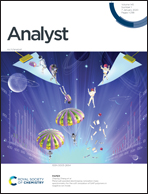Reduced graphene oxide-gold nanoparticles-catalase-based dual signal amplification strategy in a spatial-resolved ratiometric electrochemiluminescence immunoassay†
Abstract
A novel spatial-resolved electrochemiluminescent (ECL) ratiometry for cardiac troponin I (cTnI) analysis was developed using resonance energy transfer (RET) and a coreactant consumption strategy for signal amplification. Specifically, the spatial-resolved dual-disk glassy carbon electrodes were modified with CdS nanowires (CdS NWs) and luminol-gold nanoparticles (L-Au NPs) as potential-resolved ECL emitters, respectively. After stepwise immobilization of anti-cTnI and bovine serum albumin on the dual-disk electrodes, the CdS NWs-based electrode, with varied concentrations of cTnI, was used to provide a working signal, whereas the L-Au NPs-based electrode, with a fixed amount of cTnI, was employed to provide the reference signal. To efficiently amplify the working signal on the CdS NWs-based electrode, an anti-cTnI-reduced graphene oxide-gold nanoparticles-catalase probe (anti-cTnI-rGO-Au NPs-CAT) was loaded onto the electrode to form a sandwich immunocomplex. The RET from CdS NWs to Au NPs and the coreactant (i.e. H2O2) consumption by the CAT generate a significant ECL decrease on the CdS NWs-based electrode in the presence of cTnI. This novel and sensitive ratiometric detection mode for cTnI was achieved using the ratio values of the working signal of the CdS NWs-based electrode and the reference signal of the L-Au NPs-based electrode. The integration of RET and coreactant consumption strategy in the designed spatial-resolved ratiometric platform endows the immunosensor with a wide linear range of 5.0 × 10−13 – 1.0 × 10−7 g mL−1 and a low detection limit of 0.10 pg mL−1 for cTnI. Furthermore, the method exhibits high accuracy and sensitivity for cTnI determination in human serum samples.



 Please wait while we load your content...
Please wait while we load your content...